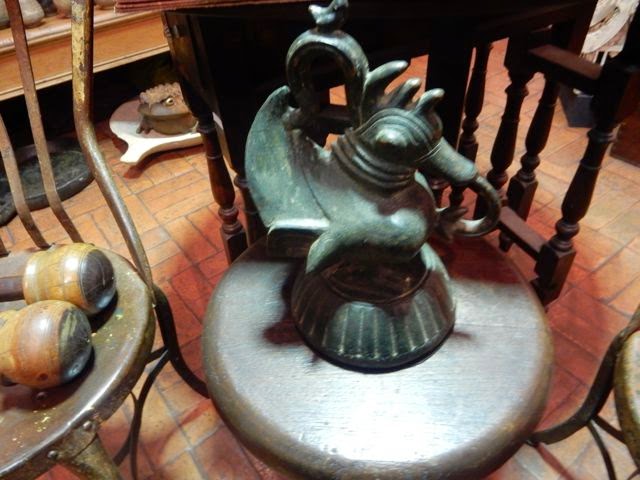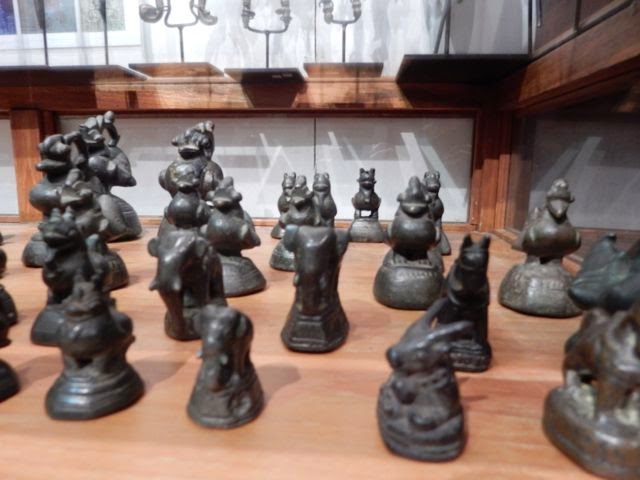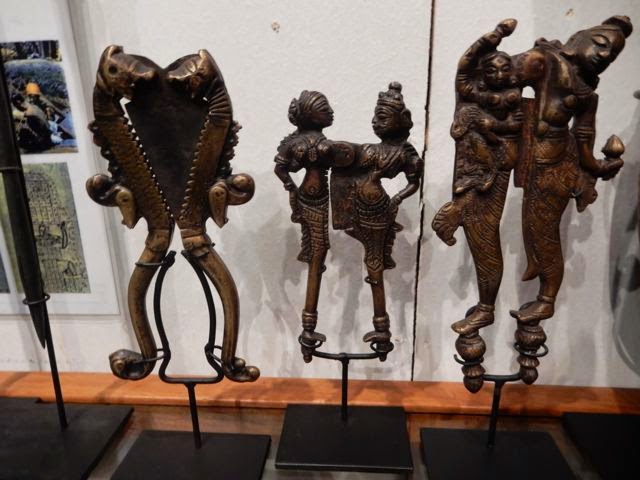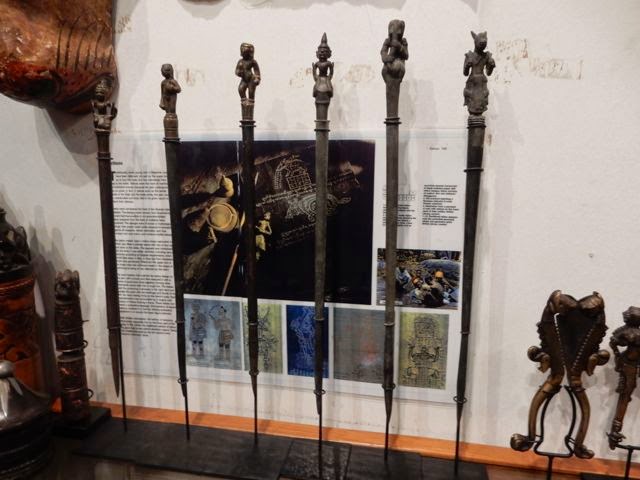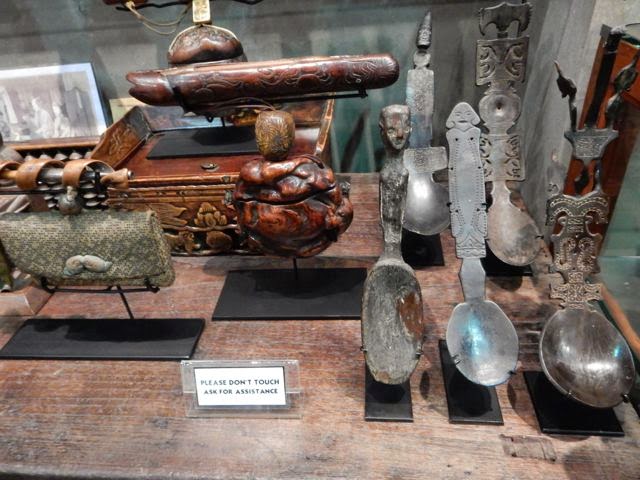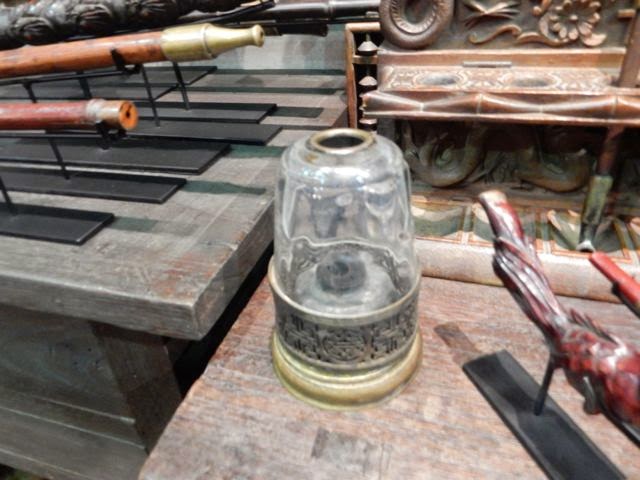Poppies and opium were not part of my own history, directly, although in Uruguay, not only as pastor for the British Community and also chaplain for the British Foreign Legion, I knew in November there was a Poppy Day (remembering Flanders Fields and all war dead from World War I and II) because that was the day the British ex-pats came out of their homes to attend Mass in our Cathedral. And I preached that Sunday for many years. And poppy seed cakes and breads popped up in bakeries.
 |
| Museum Sign in Chiang Rai |
It was when I began working with youth in Memphis, the delinquents, the abused and abandoned, and those with drug addictions that seem to have familial connections, I began to investigate the “why” of the drug world, how did it rev up in America, and when. Having lived in South America, I associated drugs with cocaine and violent Colombia, but in the ‘60ties I was a protestor and hippie during the Vietnam War (when drugs became an issue among many more than blues musicians and South American war lords). It was obvious that the drug habit crawled into the souls of our soldiers in that guerilla tragedy in Southeast Asia, a place we knew nothing about nor really had reason to care, but that France needed some forceful backup. And it hasn’t been the same since.
Centuries ago, Opium was the carrot that the British dangled before its Asian charges to be able to get into their chambers, to open the Chinese up to agreed to trade and to get all they wanted of the tea, which had become an obsession, and still is, for the British just as opium became an obsession to the people in Southeast Asia, and particularly those countries in the Golden Triangle and China.
I spent many hours in the Opium Museum, taking notes of the history compiled and displayed brilliantly in its halls. Sadly, no one can take photos and there is no catalogue, but the information in that place explains a lot of things, many of which I have heard in tidbits but never the whole story. The sad thing, this is my second visit to that site and the first one, 18 months ago, is where I learned so much about the Vietnam war and how drugs were part of the method, and how the US Air Force transported opium on its planes and how military of rank closed their eyes and ears to the ever growing drugging of our troops in these hot and humid and treacherous lands – Vietnam, Laos, Cambodia, Mynamar (Burma) and Thailand, although the latter was not an enemy in wartime. All of the references to the US participation and the discussion of Vietnam’s war has been removed. I can guess why, and that’s discouraging.
But still, the truth about the origins of opium (poppy tears) and its trade is fascinating and I will try to share “my notes” with you. In addition, in this museum, there is much helpful information about tea, since tea was the product that put opium out in the legal and illegal markets Even today opium – poppy somniferum – is still grown legally (for medicine) in North India, Turkey and Tasmania in Australia, and illegally in Afghanistan, Pakistan, Colombia and Hungary. It is the only one of the poppy species which produces the sap that can be made into opium. But it grew abundantly in the Golden Triangle along the Mekong River that was the crossroad of trade and cultures, and here, for so long, opium fields, factories and illegal drugs, trumped up by crime and corruption, instigated the abuse damaging civilizations across Asia and into the Western world.
The oldest sign of poppies was from the stone age in a Switzerland Lake, and about 3000 B.C., there was a Sumerian tax on opium. In Grecian to Egyptian art, there are dried opium poppies depicted. The Greeks scored the pods and associated poppy with the gods, as did the Romans. Claudia, the wife of Emperor Augustus, killed the son of Nero with an overdose of opium so her stepson could inherit the powers. In the Middle Ages, churches trading with Arabs and Jews, indulged in opium trade, as in the Renaissance. Thomas Sydon standardized opium which was used widely in Europe. In 18th century apothecaries in the Americas, since opium was a remedy for cough, pain and diarrhea, and still is.
From the 7th to the 13th Century Arabs controlled trade and opium was a product. It arrived in India in the 8th century, and Emperors had control over the production and sale in China in the 10th century. During the Mongul wars, elephants were fed opium to calm them so they could be controlled in battle. In the Tang Dynasty, Sun Si Maio, a physician, wrote a treatise on drugs and opium. And of course today we have Perfumes like Kenzo’s and Yves St Laurent made with oil of the papaverum
Opium was introduced 1000 years ago as a trade item but it has only been illegal less than 60 years and became a cash crop and way of life for the hill tribes in the Golden Triangle area and pinches of China near the borders. Currently Mynamar is the major producer, Laos, 2nd; Thailand, Vietnam and Yunnan,in China, small amounts.
When planting poppy somniferum, it takes 3 seeds for one hectare, it germinates in 1-2 weeks. Morphine is in the latex which must be extracted quickly or else it dries out and little morphine is left in the pods. The Latex for opium is extracted from pods by scoring – a one millimeter slice cut with specific knives, done in the afternoon, then left to ooze out overnight when it is scraped from pods early in the morning. Each pod can be scored 3-7 times. Latex is pink when fresh, black after long exposure to air.
The setting up for a opium smoke is fascinating, based on the Chinese policy of living well : pleasing the eye, delighting the mind. The pipe is long and comfortable when lying down; On a special tray, there must be a lamp, scissors to trim a wick; extra dampers arranged with special cleaners to remove dross from inside of the damper; a small box to collect the dross; small opium case for opium pellets, copper pot to boil one’s own liquid opium; opium needles to shape the opium and hold it to the flame and insert in the damper. Opium needles are 15 cm long. One end is pointed to insert opium into the damper; other end is hammered flat like a small spatula to scrape residue from the damper hole after smoking.
How to smoke: Need a special room – dim, quiet, free of draft, opium bed with cold-hard surface like tiles would comfort smokers if in for a long smoking session. Pillows and a tray with equipment since don’t want to be disturbed, a tea set, sweets tray and spittoon within reach. The smoker dresses in lose clothes and lays on his side. He takes a piece of opium the size of a small pea (0.5 grm), from opium case and rolls between thumb and finger til soft enough to stick to end of needle. The smoker warms the lower side of damper over lamp – kneads opium on dampers hot surface until it becomes deep amber color. Roll sticky opium around tip of needle, placed near the hole of damper, rotate damper to 45 degree angle about 2.5 cm from flame. Place lip on mouth piece tight before inhaling smoke to fill lungs: Opium will sizzle and release vapors til dosage finished. Smoker slowly exhales through nose. Opium is most potent on empty stomach before a meal. At least 2-3 pipes are smoked each session. Smoker rests till effects ware off. If same pipe used, damper must be cleansed or changed after 10-12 smokers.
There are so many opium items now in antique shops. (A friend in an antique shop in Bangkok let me photograph items for this blog.) Most interesting are the weights, which are a series of metal figures, usually animals, from as tiny as your small fingernail up to the sizes of modern weight balls. They are expensive treasures. Each country had it’s own particular style: Royal weights were fashioned from one of three mystic animals: lion like Singa, swan like Hamsa, and the Karawek bird. When British took over, that was wiped out. There are others: Shan weights are 12 animals repeating the cycle of 12 years of birth: turtles, fish, birds, soldiers. Lanna (North Thailand) use elephants. Laotians use monks bowls or animals; Khmu Hill Tribes – elephants with their bases formed to be useful as a seal; Chinese weights – birdlike creatures. Burma weights are either geese, swan, or ducks. Then there antique scorers of wood used by hill tribes, and scrapers, dampers and the most confusing, sharp edged porcelain pillows – big squares of porcelain, which once the smoker comes down from his high, will feel uncomfortable so he will get up and leave after the effects are gone. The Chinese have a tradition of hard pillows, but these are modified to suit the opium smoker, some a child kneeling, or reclining monks or Buddha, or mystical animals. Some have a hole for the ear to make long sessions comfy.
How opium obsession came about was really the fault of the British. Industrial Revolution in the mid 1700s which radically changed trade patterns. There were two triangles of trade: 1) Britain, Africa, Americas and 2) Britain, India, China. Every aspect of trade favored the British somehow, except trade with China. Silver flowed from Britain and other countries into China. And Opium trade from Britain to China reversed the flow of silver.
In the 1500s Portugal controlled the sea trade with the East; Spain controlled with new found Americas; by 1600 the Dutch became masters of Eastern Trade until Britain and France began to compete. London became the great world port for spices, silks and porcelain from the east; sugar, tobacco and cotton from the Americas. After the defeat of Napoleon and France in 1815, Britain was the major economical and political power for trade in the entire world.
 |
| Wooden Opium Pillows |
But it was the Dutch who introduced China tea to Britain in the early 1600s. First it was a curiosity available in a few houses and apothecaries for medicinal purposes. Catherine of Bragonza, wife of King Charles II, changed tastes and history when tea became her preferred drink. It became so popular that it became East India Company’s most important trade commodity and the British Trade Ministry, taking advantage of a strange thing, began to level more than 100 per cent duty on the tea leaves. London coffee houses were only for men, such as Lloyds coffee house where economists and financiers met – it became the insurance power Lloyds of London – as did the Jerusalem Coffee House, also favored by financiers and captains of ships to Asia. Eventually all coffee houses where tea was the drink became male only until Catherine made tea drinking chic for ladies and it was served in private homes.
On top of this, the use of porcelain for tea services created a whole new industry for England in the 1700s. Wedgewood was founded in 1812 for this reason and Queen Victoria made afternoon high tea (all those little sandwiches, scones and cakes) popular in royal circles. The wealthy kept valuable stocks of tea locked in special containers or tea caddies, until the prices fell in the mid 1800s. Then working classes could buy tea dregs (brewed tea) from the rich.
In the mid 1700s, the East India Trading Company shipped cheap manufactured cotton cloth from Britain to India and metal cookware. By mid 1970s, it imported spices, gums, resins from Asia tropics and tea, porcelain and luxury goods from China to Britain. Tea almost bankrupted the trading company. It was forced to pay for it with silver it didn’t have. Meanwhile the British put high import duties and kept tea prices low to avoid smugglers. By 1772 British loaned the East India Trading Company over 100 million pounds, then Parliament past the Tea Act of 1773 to assist the EITC, giving them direct and sole access to the tea sales and taxation in American colonies: this and taxation without representation angered our colonial ancestors and hence the Boston Tea Party, to protest the Tea Act and it was a step toward the Revolution three years later.
For centuries, India was.is the largest producer of legal opium grown in the Ganges Plain (Patha or Bengal opium), and in Mathya Pradesh and Gujaret (Malawa Opium). Even today, it is still harvested under close and controlled supervision: spring collection of opium in clay pots: large factories employ thousands of men to clean it, mix and boil the sap down; make cakes (opium balls); and to dry, stack and store opium. A specialist makes 60 balls a day and up to 16,000-20,000 in a factory in June and July. After stacking, each ball must be given a turn once every six days to dry over the next two months. Chests are prepared in September and October, packing 40 to a case (20 on bottom, 20 on top). After October, chests were sent to Calcutta for sale. Auction started in January in the 1800s, two times a year, but by the middle of 1800s, monthly.
First Portugal then the Dutch used opium profits to pay for spice trade in the Orient. Dutch bought the first opium in Bengal in 1659, and by mid 1700s shipped 1400 chests (100 tons) of Opium to Java. When EITC took control of Bengal 1757, it had control of opium and in 1816 sold that control to China. When British government abolished the EITC and took rule over India in 1858, it also took over the opium monopoly, selling to private traders. The British Government claimed they were not responsible for trade with China or its problems. Then Sir Thomas Raffles appeared, founder of Singapore, who started as a clerk in EITC and became governor of Java. Singapore became a stop off to unload goods and in 1826 a British trader set out to sell opium in Siam. Opium from India shipped on barges near Linten Island at mouth of Pearl River. Guangzhou merchants bought opium and sent small Chinese boats to unload from the barges so as to smuggle it.
The fastest vessels at this time were the clipper ships and they were used for high value trade and to beat the competition, prevent spoilage or avoid embargoes. They were used in the slave trade as well. British competed to be the first and the best with tea shipment because the first crop each year brought the higher prices, as did opium, so the Clipper ships were the answer to their prayers to be the fastest and firstest.
In China, Emperor Lin Zexu (1785-1850) set up a special commission in Guangzhou to end the opium trade. He believed in superiority of China over barbarians but this led to a humiliating defeat of China by those barbarians (British) in the first Opium Wars for which he was exiled. During the Daoguang empire in 1850 there were 30 years of turmoil and conflict with Western powers concerning opium addiction and the depletion of government treasuries to pay for the increased opium imports. But he continued to resist legalization. Empress Dowager Cixi (quite a character in history), concubine to Hsien Feng, emperior 1831-61, reigned during the 2nd Opium War. She ruled in Qing Dynasty. There was much wheeling and dealing of leaders and merchants during both Opium wars. But Opium stayed in power.
Causes suggested for these two wars were: 1) conflict between Britain and the Chinese Empire; China felt opium a threat in 1729. By 1800 EITC adapted policy to pay for tea with opium. 1839 China opium sellers spent 100 million taels of silver draining the treasury. China wanted to stop the trade. 2) Westerns wanted opium legit like tobacco and alcohol. (it was smoked mixed with tobacco from America’s eastern shores. ) 3) Vast conflicts over diplomatic conventions, freedom of trade, rights of missionaries and even manners. So the Treaty of Nanking, Aug 1842, a humiliating inequal treaty was forced on China. 4) Then came the Treaty of Tientsin (1858). In 1881 Russia annexed Llin Northwest China where Lin Zexu had been exiled after first opium war. 1895 Japan took Taiwan. 1898 New Territory (islands) north of Kowloon was leased to Britain for 99 years – and large areas on the penninsula to Russia, Germany and France. China was losing from evert side.
The Immediate effect of Opium War was it lifted trade barriers. Tea export rose from 75 million kilos to 42 million kilos between 1843-55. Silk from 2000 to 56000 bales; opium from 68000 chests in 1850 to 6 million kilos by 1873.
Many said the Opium War was the start of revolution in China. Qing Dynasty declined after decades of war. Millions suffered and corruption was everywhere. The Taiping Rebellion (1850-64) was greatest threat to the Qing Dynasty. Hong Xiuguan declared himself King of Heaven (brother of Jesus) in the Worldly Heavenly Kingdom of Great Peace. He added the prohibition of smoking opium to the Biblical Ten Commandments. Western powers preferred working with the Imperial regime to nationalists because assumed they could manipulate them better. So, the Qing Dynasty and Imperial China ended with republican rebellion of 1911 – then for 38 years warlords fought over the country. Japan took over Manchuria, then invaded the rest. Nationalists and communists fought a civil war and opium was widely available. The communists in 1949, outlawed all smoking of opium, ending the vice that had helped subject China to a century of conquest, shame and crime. During Mao’s rule, opium trade and production came pretty much to a halt. Rice was the crop he wanted everyone to plant, believing each family needed to be farmers, not anything else.. Opium production was sort of pushed back to or across the borders of neighboring countries such as Mynamar, Laos and Thailand. The fact now is that opium is becoming a popular entertainment drug again and it is moving back across the Golden Triangle borders, but also across the seas to our own country.
Post Mao, In 1988 the Princess Mother of the King of Thailand began a royal research plan for the highlands and remote villages to rehabilitate the hill tribes and change their dependence on the opium poppy. This Opium Museum is an effort not to glorify opium, as some have criticized, but to show the truth and educate people – a great part of the museum is about the impact of illegal drugs and there is, in the end, a Hall of Reflection, where visitors are asked to think about what they can do to stop the opium trade, which, sadly, is growing again, especially in the US. If this report is a bit jagged, it’s because I copied information as it came in the layout of the museum.


